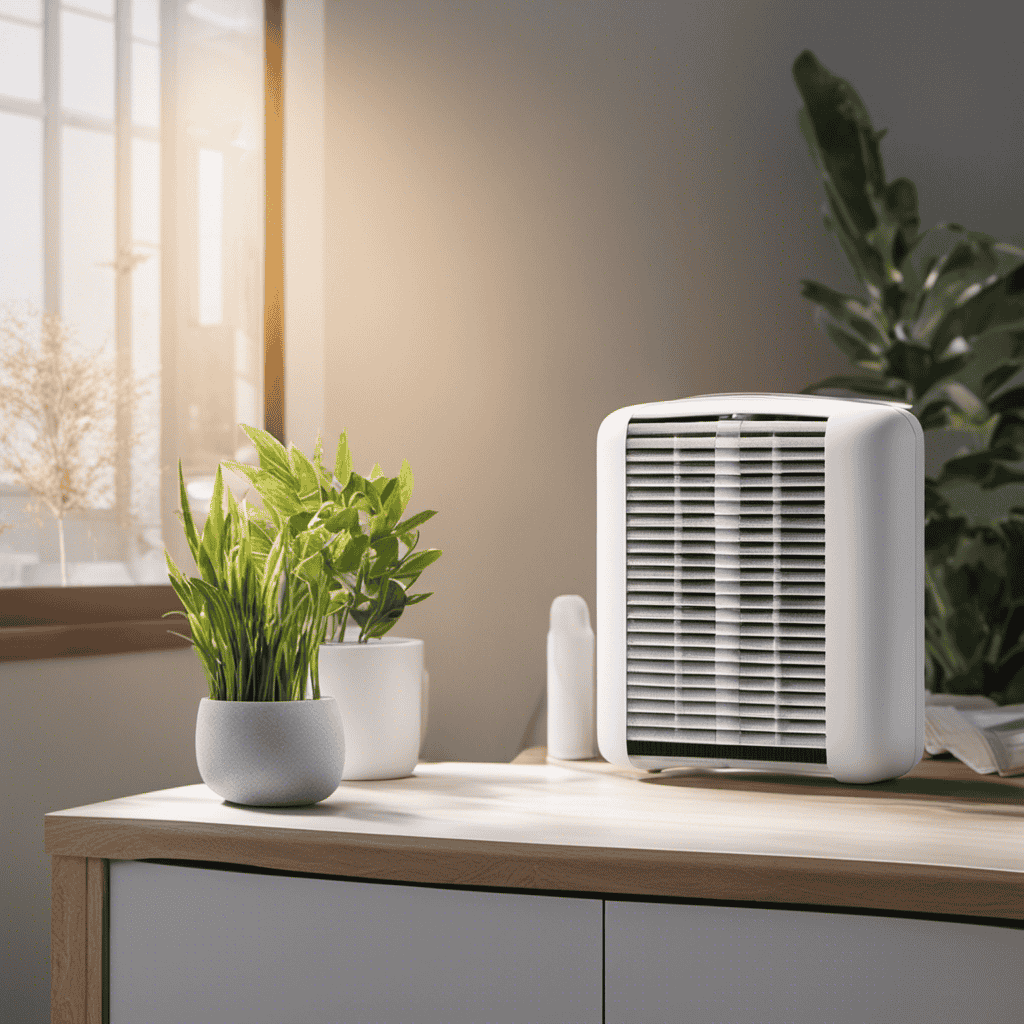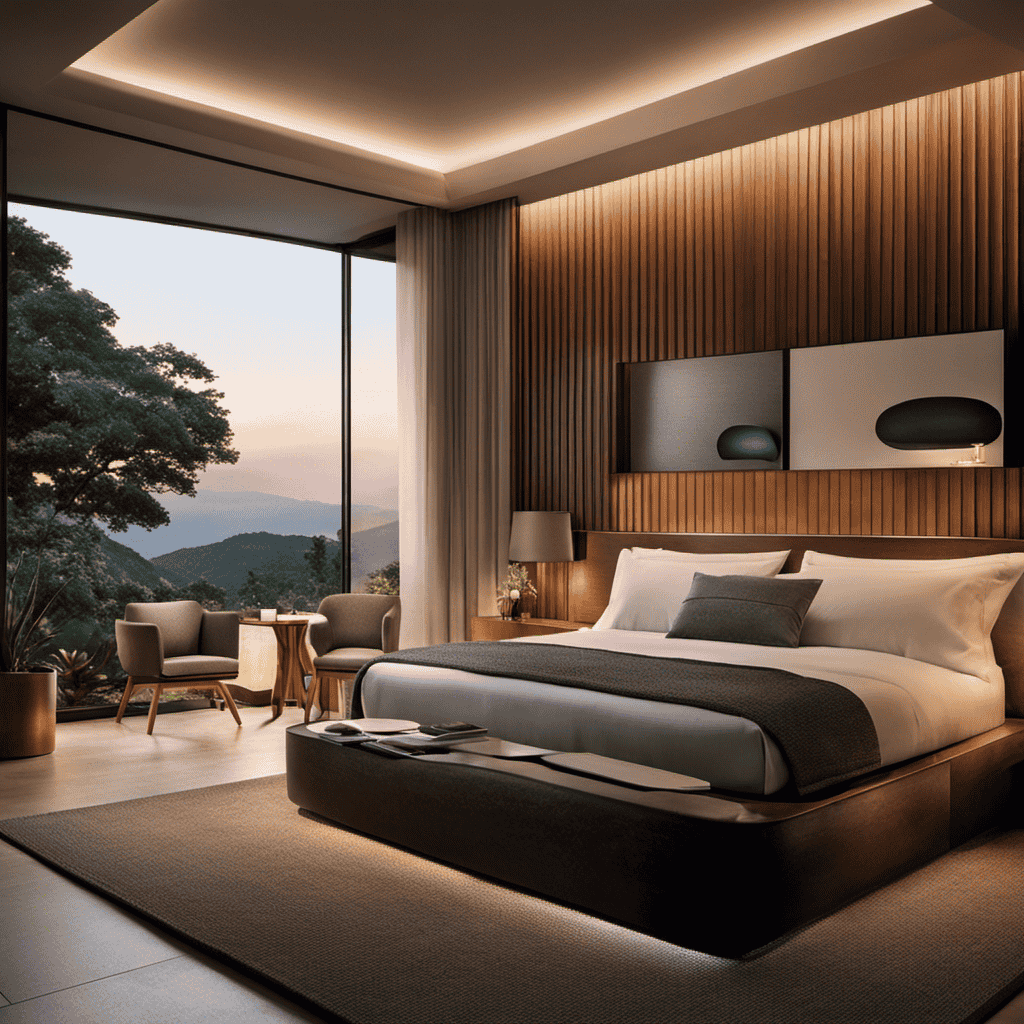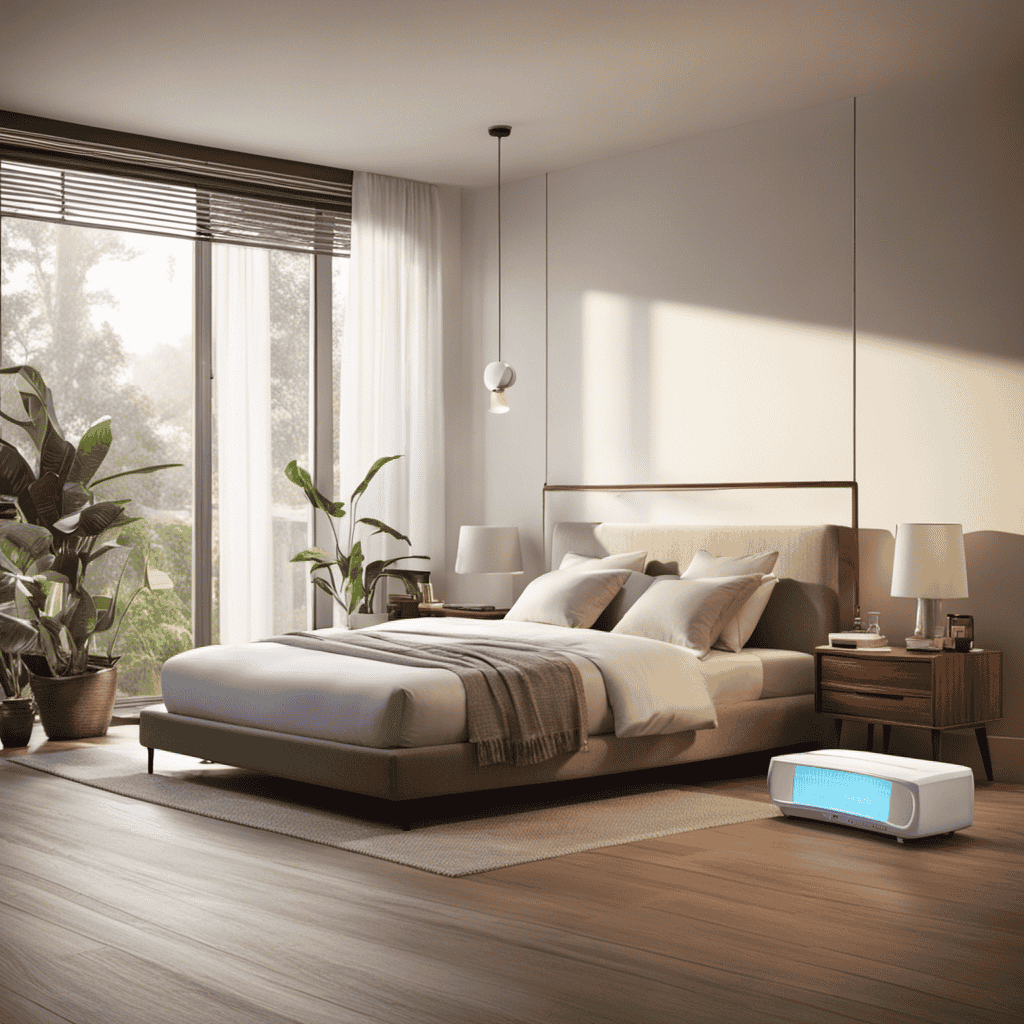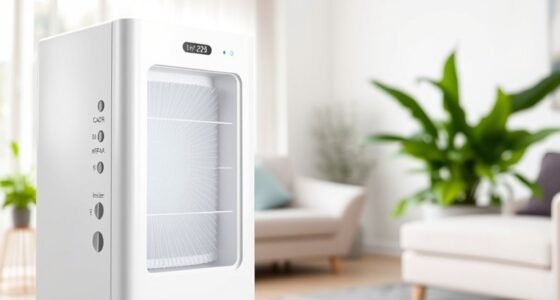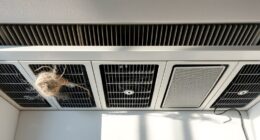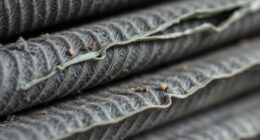Do you realize that the lifespan of an air purifier filter can fluctuate based on various factors?
In this article, I will explore the different types of air purifier filters and discuss how often they should be replaced.
I will also highlight the signs that indicate it’s time to change your filter and provide tips for extending its lifespan.
Additionally, I will delve into the role of air quality in determining filter longevity and offer guidance on how to properly clean and maintain your filter.
Key Takeaways
- Frequency of filter replacement varies based on model, usage, and air quality
- Different types of air purifier filters have different lifespans and capabilities
- Regular maintenance and proper cleaning can extend the lifespan of air purifier filters
- Reusable filters generally have a longer lifespan compared to disposable filters and offer cost-effectiveness and environmental benefits.
Factors Affecting the Lifespan of Air Purifier Filters
You should consider several factors that affect how long your air purifier filter lasts. Proper air purifier maintenance is crucial to ensure optimal performance and longevity of the filter.
One of the key factors is the frequency of filter replacement. The lifespan of an air purifier filter varies depending on the specific model, usage, and air quality. However, it is generally recommended to replace the filter every 6 to 12 months. This timeframe ensures that the filter remains effective in removing pollutants from the air.
Regular filter replacement is essential because over time, the filter gets clogged with particles, reducing its efficiency. Additionally, factors like the size of the room, the number of pollutants, and the air purifier’s fan speed can also influence the filter replacement frequency.
Understanding the Different Types of Air Purifier Filters
Understanding the various types of air purifier filters can help you make an informed decision about which one to choose. There are different types of air purifier filters available in the market, each with its own benefits and drawbacks. Let’s take a look at the different types and their characteristics:
| Filter Type | Benefits | Drawbacks |
|---|---|---|
| HEPA | Highly efficient in removing small particles such as dust, pollen, and pet dander. | May not be effective in removing gases, odors, and chemicals. |
| Activated Carbon | Excellent at removing gases, odors, and chemicals. | Less effective in removing larger particles like dust and pollen. |
| Ionizer | Can remove particles from the air and provide a fresh scent. | May produce ozone as a byproduct, which can be harmful in high concentrations. |
| UV-C | Kills bacteria and viruses. | Ineffective against particles and odors. |
| Electrostatic | Removes large particles effectively. | Requires regular cleaning to maintain efficiency. |
To ensure the optimal performance of air purifier filters, regular maintenance is necessary. Cleaning or replacing the filters according to the manufacturer’s guidelines is crucial. Filter efficiency and replacement frequency can vary depending on factors such as air quality, usage, and filter type. In the subsequent section, we will delve into how often air purifier filters should be replaced.
How Often Should Air Purifier Filters Be Replaced
Regular maintenance of air purifier filters is crucial to ensure optimal performance. This includes cleaning or replacing them according to the manufacturer’s guidelines. It’s important to know how often to change air purifier filters to maintain clean and healthy air in your home.
Here are the benefits of regular filter replacement:
-
Improved Air Quality: Regularly changing the filters helps remove allergens, dust, and pollutants from the air. This ensures cleaner and healthier indoor air quality.
-
Enhanced Performance: Clean filters allow the air purifier to function at its best. They effectively capture particles and maintain a high level of filtration efficiency.
-
Prolonged Lifespan of the Air Purifier: By replacing the filters as recommended, you can extend the lifespan of your air purifier. This helps you avoid potential breakdowns or costly repairs.
Following the manufacturer’s guidelines for filter replacement will help you enjoy these benefits and keep your air purifier working efficiently.
Signs That Indicate It’s Time to Change Your Air Purifier Filter
If you notice reduced airflow or a musty smell coming from your air purifier, it’s likely time to change the filter. A clogged or dirty filter can hinder the efficiency of your air purifier, reducing its ability to remove airborne pollutants effectively.
So, how do you choose the right air purifier filter? Firstly, consider the type of pollutants you want to target. HEPA filters are highly recommended for capturing particles as small as 0.3 microns, including pollen, pet dander, and dust mites.
Secondly, consider the lifespan and maintenance of the filter. Reusable air purifier filters, while more expensive upfront, can be washed and reused multiple times, making them cost-effective in the long run. However, they may not be as effective in trapping smaller particles compared to disposable filters.
Ultimately, the choice depends on your specific needs and preferences.
Do Reusable Air Purifier Filters Last Longer
Reusable air purifier filters typically have a longer lifespan compared to disposable filters. This is because reusable filters are designed to be washed and reused multiple times, whereas disposable filters need to be replaced entirely.
Here are some benefits of using reusable air purifier filters:
-
Cost-effective: Reusable filters may have a higher upfront cost, but they can save you money in the long run since you don’t have to constantly purchase new filters.
-
Environmental impact: By using reusable filters, you reduce the amount of waste generated by disposable filters. This contributes to a more sustainable and eco-friendly lifestyle.
-
Efficiency: Reusable filters are often made with high-quality materials that can effectively capture and remove pollutants from the air, ensuring cleaner indoor air quality.
Overall, choosing reusable air purifier filters not only benefits your wallet but also has a positive impact on the environment and the air you breathe.
Tips for Extending the Lifespan of Your Air Purifier Filter
To maximize the lifespan of your air purifier filter, it’s important to regularly clean and maintain it. By doing so, you can ensure optimal performance and extend the life of your filter.
The best cleaning methods for air purifier filters depend on the type of filter you have. For reusable filters, gently vacuuming or washing with warm water and mild detergent is recommended. Disposable filters should be replaced according to the manufacturer’s instructions.
Additionally, it’s crucial to keep an eye on the air quality in your surroundings. High levels of pollutants can cause filters to clog more quickly and reduce their lifespan. Regularly monitoring and improving the air quality in your home or office can help in prolonging the lifespan of your air purifier filter.
The Role of Air Quality in Determining Filter Longevity
Monitoring and improving the air quality around you will directly impact how long your filter will stay effective. The role of air pollutants in determining filter longevity is crucial.
Air pollution, caused by various sources such as vehicle emissions, industrial activities, and household chemicals, contains harmful particles and gases. These pollutants, including fine particulate matter (PM2.5), volatile organic compounds (VOCs), and nitrogen dioxide (NO2), can reduce the lifespan of your air purifier filter. They can clog the filter faster and decrease its efficiency in trapping pollutants.
Moreover, the impact of air pollution on health cannot be overlooked. Exposure to these pollutants can lead to respiratory issues, allergies, and even more severe health conditions. Therefore, it is essential to be aware of the air quality in your environment and take necessary steps to improve it for the longevity of your filter and the well-being of your health.
- Fine particulate matter (PM2.5)
- Volatile organic compounds (VOCs)
- Nitrogen dioxide (NO2)
How to Properly Clean and Maintain Your Air Purifier Filter
Now that we understand the importance of air quality in determining the longevity of an air purifier filter, let’s delve into how to properly clean and maintain your filter.
Proper cleaning methods are crucial to ensure optimal performance and prolong the lifespan of your filter. Firstly, always refer to the manufacturer’s instructions for specific cleaning guidelines.
Generally, pre-filters can be vacuumed or washed with water and mild soap, while HEPA filters may require more delicate handling. Avoid using harsh chemicals or excessive force, as this can damage the filter.
Additionally, be mindful of common mistakes to avoid, such as neglecting regular cleaning or over-cleaning the filter, which can compromise its effectiveness.
Factors to Consider When Purchasing Replacement Filters for Your Air Purifier
When it comes to purchasing replacement filters for your air purifier, there are several factors to consider.
First and foremost is the lifespan of the filter, which can vary depending on factors such as air quality and usage.
It’s also important to ensure that you choose compatible filter options for your specific air purifier model, as using the wrong filter can compromise its effectiveness.
Lastly, cost-effective replacement filters are a key consideration, as you want to find a balance between quality and affordability.
Filter Lifespan Factors
To keep your air purifier filter working efficiently, you’ll want to consider factors such as your home’s air quality and the frequency of filter replacements. Maintaining your filter properly can extend its lifespan and maximize its performance.
Here are some tips to help you get the most out of your filter:
-
Regular cleaning: Cleaning your filter regularly can help remove dust and debris, allowing it to function more effectively.
-
Reusable filter benefits: Investing in a reusable filter can save you money in the long run, as you can clean and reuse it multiple times.
-
Filter replacement schedule: It’s important to follow the manufacturer’s recommendations for filter replacements. Replacing your filter at the recommended intervals ensures optimal air purification.
Compatible Filter Options
If you want to find compatible filter options for your air purifier, you can consult the manufacturer’s website or contact customer support for assistance. It’s important to use compatible filter brands to ensure optimal performance and efficiency of your air purifier.
Different air purifier models may require specific filters, so it’s essential to check the manufacturer’s recommendations. Additionally, proper filter maintenance is crucial to extend the lifespan of your filters. Regularly cleaning or replacing the filters according to the manufacturer’s instructions will help maintain their effectiveness in removing airborne pollutants.
Some filter maintenance tips include vacuuming or washing pre-filters, replacing activated carbon filters every 3-6 months, and replacing HEPA filters every 6-12 months. By following these guidelines, you can ensure that your air purifier continues to provide clean and healthy air for your indoor environment.
Looking for cost-effective replacement filters? Let’s explore that in the next section.
Cost-Effective Replacement Filters
After discussing the compatible filter options in my previous subtopic, let’s now delve into the world of cost-effective replacement filters for air purifiers. As a savvy consumer, I understand the importance of finding high-quality filters that won’t break the bank. Here are some cost-effective brands to consider:
- Brand A: Known for their affordable filters without compromising on performance.
- Brand B: Offers budget-friendly options with excellent filtration capabilities.
- Brand C: Provides cost-effective filters that are long-lasting and effective in capturing airborne particles.
To ensure the longevity and efficiency of your air purifier filters, it’s essential to follow these maintenance tips:
- Regularly clean or replace filters as recommended by the manufacturer.
- Vacuum the pre-filter to remove large particles and debris.
- Avoid exposing filters to excessive moisture, which can lead to mold growth.
Frequently Asked Questions
Can I Wash and Reuse My Air Purifier Filter?
Yes, you can wash and reuse some air purifier filters. However, not all filters are washable. It’s important to check the manufacturer’s instructions before attempting to clean or reuse your filter.
How Do I Know if My Air Purifier Filter Needs to Be Replaced?
I clean my air purifier filter every 3 months to ensure it’s working efficiently. Signs of a clogged filter include reduced airflow and a decrease in air quality. Regular maintenance is key for optimal performance.
Can I Use a Different Brand of Filter in My Air Purifier?
Using a different brand of filter in your air purifier may compromise its performance and potentially damage the device. It is best to stick with filters that are recommended by the manufacturer for optimal filter compatibility.
Is It Necessary to Replace the Pre-Filter as Frequently as the Main Filter?
It is important to consider the maintenance of the pre-filter in order to extend the lifespan of the main filter. Regularly replacing the pre-filter can help prevent clogging and ensure optimal performance of the air purifier.
Can I Extend the Lifespan of My Air Purifier Filter by Using It on a Lower Fan Speed Setting?
To increase the lifespan of an air purifier filter without adjusting fan speed, there are a few ways. Properly cleaning and maintaining the filter regularly is essential for optimal performance and longevity.
What is the Lifespan of an Air Purifier Filter Compared to the Overall Lifespan of an Air Purifier?
The lifespan of an air purifier filter depends on usage and maintenance. Typically, filters last between 6-12 months. However, the overall lifespan of an air purifier is usually 5-15 years, depending on the model and usage. Understanding how long do purifiers last will help in maintaining the air quality at home.
Conclusion
In conclusion, maintaining the lifespan of your air purifier filter is crucial for ensuring clean and healthy indoor air.
Based on research, it is recommended to replace your air purifier filter every 6 to 12 months, depending on the type of filter and the level of air pollution in your environment.
Interestingly, a study found that a clogged air purifier filter can reduce its efficiency by up to 50%, which is equivalent to breathing in air that is half as clean.
So, it’s essential to regularly monitor and replace your filter to ensure optimal air purification.
